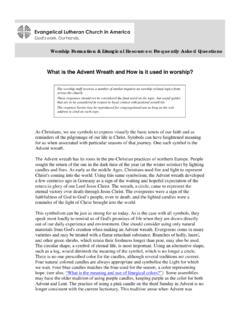Transcription of The Economics of the Coming Spaceship Earth Kenneth E ...
1 1. The Economics of the Coming Spaceship Earth Kenneth E. Boulding In H. Jarrett (ed.) 1966. Environmental Quality in a Growing Economy, pp. 3-14. Baltimore, MD: Resources for the Future/Johns Hopkins University Press. First presented by Kenneth Ewart Boulding at the Sixth Resources for the Future Forum on Environmental Quality in a Growing Economy in Washington, on March 8,1966. We are now in the middle of a long process of transition in the nature of the image which man has of himself and his environment. Primitive men, and to a large extent also men of the early civilizations, imagined themselves to be living on a virtually illimitable plane. There was almost always somewhere beyond the known limits of human habitation, and over a very large part of the time that man has been on Earth , there has been something like a frontier.
2 That is, there was always some place else to go when things got too difficult, either by reason of the deterioration of the natural environment or a deterioration of the social structure in places where people happened to live. The image of the frontier is probably one of the oldest images of mankind, and it is not surprising that we find it hard to get rid of. Gradually, however, man has been accustoming himself to the notion of the spherical Earth and a closed sphere of human activity. A few unusual spirits among the ancient Greeks perceived that the Earth was a sphere. It was only with the circumnavigations and the geographical explorations of the fifteenth and sixteenth centuries, however, that the fact that the Earth was a sphere became at all widely known and accepted. Even in the nineteenth century, the commonest map was Mercator's projection, which visualizes the Earth as an illimitable cylinder, essentially a plane wrapped around the globe, and it was not until the Second World War and the development of the air age that the global nature of the planet really entered the popular imagination.
3 Even now we are very far from having made the moral, political, and psychological adjustments which are implied in this transition from the 2. illimitable plane to the closed sphere. Economists in particular, for the most part, have failed to come to grips with the ultimate consequences of the transition from the open to the closed Earth . One hesitates to use the terms "open" and "closed" in this connection, as they have been used with so many different shades of meaning . Nevertheless, it is hard to find equivalents. The open system, indeed, has some similarities to the open system of von Bertalanffy, in that it implies that some kind of a structure is maintained in the midst of a throughput from inputs to outputs.[1] In a closed system, the outputs of all parts of the system are linked to the inputs of other parts.
4 There are no inputs from outside and no outputs to the outside; indeed, there is no outside at all. Closed systems, in fact, are very rare in human experience, in fact almost by definition unknowable, for if there are genuinely closed systems around us, we have no way of getting information into them or out of them; and hence if they are really closed, we would be quite unaware of their existence. We can only find out about a closed system if we participate in it. Some isolated primitive societies may have approximated to this, but even these had to take inputs from the environment and give outputs to it. All living organisms, including man himself, are open systems. They have to receive inputs in the shape of air, food, water, and give off outputs in the form of effluvia and excrement.
5 Deprivation of input of air, even for a few minutes, is fatal. Deprivation of the ability to obtain any input or to dispose of any output is fatal in a relatively short time. All human societies have likewise been open systems. They receive inputs from the Earth , the atmosphere, and the waters, and they give outputs into these reservoirs; they also produce inputs internally in the shape of babies and outputs in the shape of corpses. Given a capacity to draw upon inputs and to get rid of outputs, an open system of this kind can persist indefinitely. There are some systems - such as the biological phenotype, for instance the human body - which cannot maintain themselves indefinitely by inputs and outputs because of the phenomenon of aging. This process is very little understood. It occurs, evidently, because there are some outputs which cannot be replaced by any known input.
6 There is not the same necessity for aging in organizations and in societies, although an 3. analogous phenomenon may take place. The structure and composition of an organization or society, however, can be maintained by inputs of fresh personnel from birth and education as the existing personnel ages and eventually dies. Here we have an interesting example of a system which seems to maintain itself by the self-generation of inputs, and in this sense is moving towards closure. The input of people (that is, babies) is also an output of people (that is, parents). Systems may be open or closed in respect to a number of classes of inputs and outputs. Three important classes are matter, energy, and information. The present world economy is open in regard to all three. We can think of the world economy or "econosphere" as a subset of the "world set," which is the set of all objects of possible discourse in the world.
7 We then think of the state of the econosphere at anyone moment as being the total capital stock, that is, the set of all objects, people, organizations, and so on, which are interesting from the point of view of the system of exchange. This total stock of capital is clearly an open system in the sense that it has inputs and outputs, inputs being production which adds to the capital stock, outputs being consumption which subtracts from it. From a material point of view, we see objects passing from the noneconomic into the economic set in the process of production, and we similarly see products passing out of the economic set as their value becomes zero. Thus we see the econosphere as a material process involving the discovery and mining of fossil fuels, ores, etc., and at the other end a process by which the effluents of the system are passed out into noneconomic reservoirs - for instance, the atmosphere and the oceans - which are not appropriated and do not enter into the exchange system.
8 From the point of view of the energy system, the econosphere involves inputs of available energy in the form, say, of water power, fossil fuels, or sunlight, which are necessary in order to create the material throughput and to move matter from the noneconomic set into the economic set or even out of it again;. and energy itself is given off by the system in a less available form, mostly in the form of heat. These inputs of available energy must come either from the sun (the energy supplied by other stars being assumed to be negligible) or it may come from the Earth itself, either through its internal heat or through its 4. energy of rotation or other motions, which generate, for instance, the energy of the tides. Agriculture, a few solar machines, and water power use the current available energy income.
9 In advanced societies this is supplemented very extensively by the use of fossil fuels, which represent as it were a capital stock of stored-up sunshine. Because of this capital stock of energy, we have been able to maintain an energy input into the system, particularly over the last two centuries, much larger than we would have been able to do with existing techniques if we had had to rely on the current input of available energy from the sun or the Earth itself. This supplementary input, however, is by its very nature exhaustible. The inputs and outputs of information are more subtle and harder to trace, but also represent an open system, related to, but not wholly dependent on, the transformations of matter and energy. By far the larger amount of information and knowledge is self-generated by the human society, though a certain amount of information comes into the sociosphere in the form of light from the universe outside.
10 The information that comes from the universe has certainly affected man's image of himself and of his environment, as we can easily visualize if we suppose that we lived on a planet with a total cloud-cover that kept out all information from the exterior universe. It is only in very recent times, of course, that the information Coming in from the universe has been captured and coded into the form of a complex image of what the universe is like outside the Earth ; but even in primitive times, man's perception of the heavenly bodies has always profoundly affected his image of Earth and of himself. It is the information generated within the planet, however, and particularly that generated by man himself, which forms by far the larger part of the information system. We can think of the stock of knowledge, or as Teilhard de Chardin called it, the "noosphere," and consider this as an open system, losing knowledge through aging and death and gaining it through birth and education and the ordinary experience of life.

